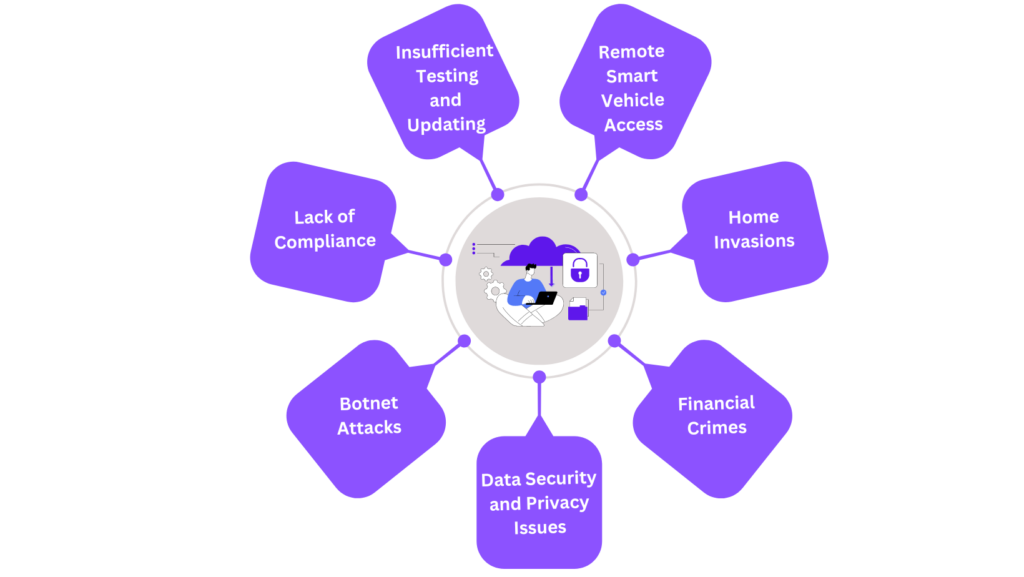Our affinity for smart devices, providing real-time information, tracking essential data, and facilitating constant connectivity, is driving the increasing integration of Internet of Things (IoT) technology into daily life, virtual devices, lifestyle practices, and business operations. Statista reports over 15 billion connected devices globally, a number projected to double by 2030.
Why is Cybersecurity in IoT Important?
The significance of cybersecurity in IoT arises from the interconnection of objects and devices to the internet, enabling the seamless accumulation and transmission of data without human intervention. However, granting control to the internet exposes IoT devices to potential cyber-attacks and disruptive interventions.
In the era where IoT has emerged as a transformative force, the importance of cybersecurity has escalated significantly, presenting both crucial necessity and considerable challenges. As indicated by the Unit 42 IoT threat report, a substantial 98% of all IoT device traffic lacks encryption, thereby exposing personal and confidential data across the network—a glaring illustration of the cybersecurity risks associated with IoT. The report further emphasizes that 57% of IoT devices face susceptibility to attacks of medium or high severity. Additionally, 41% of these attacks exploit vulnerabilities in the devices, underscoring the evident challenges in ensuring robust security for IoT.
In the absence of sufficient security measures within the Internet of Things (IoT), every interconnected device becomes a direct entry point to our personal and professional networks. The IoT holds highly sensitive data, especially in critical sectors such as defense, finance, and healthcare. If malicious attackers gain access to IoT devices, they can effortlessly extract valuable information or compromise the entire network. Therefore, cybersecurity in IoT is imperative, as a single theft or hack has the potential to disrupt the entire network or grant cybercriminals unfettered access to the system.
Why is Cybersecurity in IoT Important?
The advent of IoT has transformed the dynamics of our interactions with smart devices, offering unparalleled convenience and efficiency. Yet, as IoT becomes increasingly prevalent in sectors like healthcare and finance, numerous security vulnerabilities have surfaced. This underscores the importance for businesses to adopt a proactive stance in safeguarding IoT ecosystems against potential attacks.
The advent of IoT has transformed the interaction with smart devices, providing unparalleled convenience and efficiency. Yet, the extensive incorporation of IoT in healthcare, finance, and various industries has brought forth numerous security vulnerabilities. This necessitates businesses to adopt a proactive stance in safeguarding IoT ecosystems from potential attacks.

1. Insufficient Testing and Updating
A significant challenge faced by companies in implementing IoT security technologies is negligence towards data privacy and protection unless a major issue arises. While IoT manufacturers initially ensure the security of their devices, the lack of continuous testing and updating over time makes them vulnerable to hackers and other security issues. This opens the door to challenges in IoT cybersecurity.
Also Read: FinTech Cybersecurity – Building a Financial App with Proactive Security Measures
2. Lack of Compliance
To illustrate the issue, consider the everyday use of IoT devices. For instance, fitness trackers often keep Bluetooth visible even after the initial pairing. A smart refrigerator may inadvertently expose Gmail credentials, and a smart fingerprint padlock could be accessed using a Bluetooth key with the same MAC address as the padlock device. These scenarios highlight the cybersecurity threats associated with IoT.
Manufacturers’ IoT devices face several security issues, including:
- Weak and easily guessable passwords
- Use of outdated operating systems and software
- Insecure and unprotected data storage and transfer
- Technical flaws in the hardware
3. Botnet Attacks
Securing IoT devices is paramount due to their high susceptibility to malware attacks. Unlike computers, these devices often lack regular software security updates. In a botnet attack scenario, a hacker creates a network of infected bots with malware and directs them to flood the target with thousands of requests per second, aiming to bring it down.
The convergence of IoT and cybersecurity is essential to prevent potential attacks. A botnet attack poses a significant security threat to critical infrastructure such as transportation systems, manufacturing plants, water treatment facilities, and electrical grids, potentially endangering large groups of people.
4. Data Security and Privacy Issues
Even visionaries like Elon Musk and reputed companies like Apple, renowned for their robust security claims, have not been immune to hackers. The compromise of such data not only results in financial losses but also jeopardizes intellectual property.
According to Microsoft reports 60% of employees consider IoT one of the least secure aspects of their organizations. Surprisingly, less than 50% of organizations have implemented best practices explicitly designed to secure their IoT and OT devices. According to DataProt states, 83% of organizations have experienced enhanced efficiency by implementing IoT data security measures.
5. Financial Crimes
Companies in the electronic payment sector adopting the Internet of Things may face an increase in financial crimes. Timely detection of fraud poses a significant challenge.
6. Home Invasions
The concept of ‘smart homes,’ a result of IoT, has raised significant concerns about cybersecurity, especially in the realm of home automation. Due to insecure devices and inadequate defence mechanisms, IP addresses become traceable, making it easier for hackers to identify the device’s location.
7. Remote Smart Vehicle Access
An IoT security concern akin to home invasion is the potential hijacking of smart vehicles. This poses risks such as theft of personal data, vehicle theft, and manipulation of safety-critical systems.
Furthermore, remote vehicle access may be susceptible to ransomware, where a hacker demands a significant fee to unlock the car or enable the engine. These malicious intrusions pose a substantial threat to public safety as they can lead to accidents.
Explore More: Understanding the Internet of Things (IoT) and Its Functionality
Addressing these challenges and vulnerabilities in IoT cybersecurity becomes crucial as the Internet of Things (IoT) gains widespread adoption in our daily lives and industries. Strengthening cybersecurity for the Internet of Things is essential to unlock the full potential of this transformative technology while ensuring user privacy and guarding against potential threats.
How to Safeguard IoT Devices Against Cyber Attacks
Securing IoT devices against cyber threats has become a top priority for businesses in the wake of significant hacking attacks like Stuxnet, Brickerbot, Mirai botnet, and Abbot. Recognizing the critical nature of IoT cybersecurity challenges and vulnerabilities, businesses are now proactively adopting essential measures to address security gaps and thwart potential data breaches before they cause widespread damage.
To ensure the safety of IoT connections and protect against cyber threats, businesses should prioritize a proactive approach and implement robust IoT cybersecurity solutions. Here are some recommended best practices for businesses to secure their IoT connections:

1. Secure Network Infrastructure
Securing the network that acts as the intermediary between IoT devices and back-end systems is crucial. This can be accomplished by integrating security features like antivirus software, anti-malware tools, firewalls, intrusion detection systems, virtual private networks (VPNs), and preventive systems.
2. Strong Authentication
Implementing strong authentication features for connected devices emerges as a highly effective solution in IoT cybersecurity. Incorporating elements such as multi-factor authentication, digital certificates, and biometric systems ensures that unauthorized access to your devices is prevented. This security measure requires potential attackers to possess personal information, significantly reducing the risk of your data falling into the wrong hands. By adopting these recommended security options, your IoT devices become well-protected against external security breaches, allowing you to enjoy the numerous benefits of IoT in cybersecurity across various settings such as home, office, automobile, and beyond.
For further insights, explore the top 18 IoT Trends That Every Entrepreneur Must Know.
3. Public Key Infrastructure (PKI) Strategy
Public Key Infrastructure (PKI) enables secure communication, data exchange, and financial transactions by utilizing public and private cryptographic key pairs.
4. IoT Security Analytics
Implementing security analytics can significantly reduce the number of security issues faced. This process involves gathering, correlating, and analysing data from multiple sources, aiding IoT security providers in identifying potential threats.
5. Secure Device Management
To enhance security measures and respond effectively to potential threats, businesses should implement secure device management best practices. This involves employing strong password strategies, adopting remote device monitoring, and establishing centralised control. Ensure the use of unique passwords for each device and regularly update them. Avoid common or easily guessable passwords like “your name,” “date of birth,” or “123456.”
6. Regular Monitoring and Security Updates
To enhance security measures and respond effectively to potential threats, businesses should implement secure device management best practices. This involves employing strong password strategies, adopting remote device monitoring, and establishing centralised control. Ensure the use of unique passwords for each device and regularly update them. Avoid common or easily guessable passwords like “your name,” “date of birth,” or “123456.”
Reinforce Cyber Security in IoT with Digiatto IT Services
Strengthening IoT cybersecurity is imperative as IoT devices proliferate, increasing the risk of potential cyberattacks. To counter these security challenges, organisations must proactively implement creative solutions. Partnering with a reputable IoT app development company, such as Digiatto IT Services, proves invaluable in this effort.
Utilizing our IoT development services empowers businesses to greatly bolster their IoT cybersecurity, safeguard critical assets, and uphold customer trust in our interconnected world.
FAQs
Q. What is IoT cybersecurity?
IoT cybersecurity involves the implementation of practices to safeguard IoT devices, including home automation systems, SCADA machines, security cameras, and other interconnected devices, against unauthorized access, cyber threats, and vulnerabilities.
Q. How Can IoT Cybersecurity be Improved?
Enhancing cybersecurity in IoT involves adopting the following best practices:
- Modify default passwords
- Utilise encrypted protocols
- Secure the network infrastructure
- Implement authentication for IoT devices
- Leverage IoT security analytics
- Regularly monitor and update IoT systems
- Safeguard data privacy.
Q. Why is cyber security important in IoT?
The growing popularity of smart devices underscores the increasing significance of cybersecurity in IoT. With IoT devices containing extensive sensitive data, they are susceptible to cyber threats, posing potentially severe consequences. Therefore, adopting IoT security technologies becomes crucial to guarantee user privacy, uphold data confidentiality, ensure data integrity and availability, and prevent unauthorized access to connected devices. Prioritizing cybersecurity in IoT allows businesses to mitigate the risks of potential attacks, uphold trust in connected technologies, and safeguard critical information from malicious attackers.



Pingback: What is predictive analytics? Dispelling some common myths - HealthSaaSPro